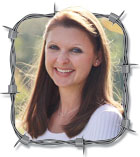Understanding cattle is impossible, or is it? Cattle workings on our farm have always been quite a sight, just like any other farm I’m sure. Parents, siblings and neighbors all pitched in on the big round-up day. I’m sure most of you can recall a few arguments and that one crazy cow that messes up the rest of the bunch!
Cattle workings on our farm have became much more calm, cool and collective through the years. My husband likes to tell everyone the story of how I tested him, to see if he would fit into our family – with a cattle working. He passed, but not after seeing how the Baldwin family communicates when working cattle. But, even after seeing that he married into our family – God love him!
But, there are ways to understand your cattle that can make the day much easier and pleasant for everyone. Dr. Temple Grandin has answers to help producers better understand their livestock.
If you haven’t heard of Dr. Grandin before, then you must have missed the numerous times that Ozarks Farm & Neighbor has mentioned this incredible lady. She is a Professor of Animal Science at Colorado State University and designer of livestock handling facilities. In fact, almost half of the cattle in North America are handled in a center track restrainer system that she designed for meat plants. Her curved chute and race systems design and ideas on principals of grazing animal behavior aid producers in creating a low stress environment for their animals. But, to many she has became the voice for livestock through her development of an objective scoring system for assessing handling of cattle and pigs at meat plants that has allowed large scale corporations to improve animal welfare.
Dr. Grandin understands animals, because she says “people with autism, like me, think the way animals do – we are both sensory based,” meaning smell, taste, noise and not verbal based communication. Dr. Grandin discussed her life as an autistic adult and touched on ways we can learn to understand livestock at a recent presentation at Drury University in Springfield, Mo.
Here were some of the tips I gathered from her presentation:
1. Cattle avoid crossing streaks of light when walking into a corral or chute.
2. Build a symbiotic relationship with animals and give them a decent life and end.
3. Understand what a chute is like, by getting on the animals level.
4. Grandin’s livestock facilities are curved because cattle naturally want to go back where they came from.
5. Calm animals are easier to handle – don’t yell at livestock – it takes 30 minutes to calm them back down.
6. Always make the first experience for an animal a pleasant one – animals do not like surprises. Therefore, if you are going to introduce them to a 4-wheeler or diesel truck, make sure it’s slow and a happy experience, or that animal will always associate bad memories with that sound.
7. Animals’ fears are very specific – “a horse afraid of a man in a black cowboy hat because he was abused by a man in a black cowboy hat,” explained Dr. Grandin.
Dr. Grandin is an amazing woman and I applaud her for what she has done for the livestock industry. Many of us can learn from her evaluations of how animals and autistic people think.
“I like the logical way I think – I don’t like the sloppy and disordered way most people think,” she said as the audience began laughing.
Here’s to a new way of communicating with our livestock.






